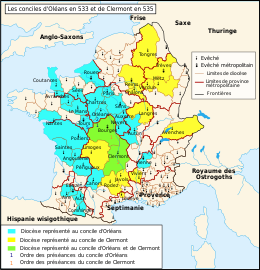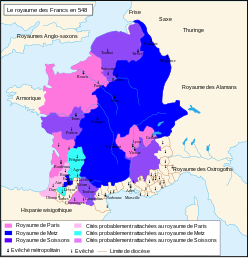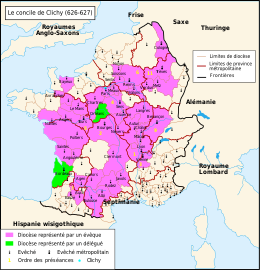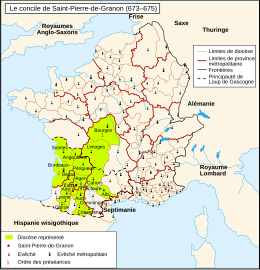Draft:Vasconia
Vasconia 5th century – 8th century | |||||||||||||||||
|---|---|---|---|---|---|---|---|---|---|---|---|---|---|---|---|---|---|
 Extent of Vasconia in the early 8th century. | |||||||||||||||||
| Status | Vascones territory | ||||||||||||||||
| Other languages | Aquitanian (proto-basque) and Medieval Latin | ||||||||||||||||
| |||||||||||||||||
Vasconia, or Gascony, was a territory controlled militarily and politically by the Vascones from the end of the 2nd century to the 11th century, stretching along both sides of the Pyrenees and defending against natural Franks, Visigothic and Muslim attacks. North of the Pyrenees, its frontier fluctuated from the Aire-Lescar axis at the end of the first century to beyond the Garonne in the seventh century. South of the Pyrenees, its frontier ran from the Vitoria-Olite axis to Zaragoza in the second and third centuries.[1]
There were two Vasconies, separated by the natural border of the Pyrenees. The later Vasconia, located in Iberia, south of the Pyrenees, and the anterior Vasconia,[2][3] located north of the Pyrenees, which became the Duchy of Gascony, a name that replaced Novempopulania in 626.[4][5]
Etymology[edit]
In south-western France, the letter "v" has always been pronounced "b", so that from the point of view of historical linguistics, Vascon and Basques are the same word. Similarly, in Old French, the letter "v" was pronounced like a "hard g" (Willaume is read Guillaume), so that Wascon is pronounced Gascon.
After the fall of the Roman Empire, the Basques came to be known as Baskones (Vascons) (gentility of Basque, "basko"). This was the first name given to the Basque people as a whole, and also identified their first political organization: the Duchy of Gascony.[6]
"Baskonia" appeared for the first time on a Ptolemy map in the 1st century and, like Strabo and Poseidonios before him, presented two distinct passages relating to the Ouaskoonooï. But he referred only to the pre-Roman Vascone tribe. The term also appeared on Paulinus of Nola's fourth-century map (394.
In 587, the Frankish chronicler Gregory of Tours refers to "Wasconia" with a "W". Thanks to his writings, we know that this territory was to undergo its third major invasion, after those of the Romans and Visigoths, i.e. that of the "Franks". The Vascones were to suffer major attacks, this time on a massive scale. The military pressure exerted by the Franks was such that all the proto-Basque or Aquitani tribes joined forces to create a first political unit under the name of "Duchy of Gascony".
In the 6th century, the cosmographer Anonymous of Ravenna included "Baskonia" in his map. He distinguished between two zones, "Guasconia" or "Vasconum patria" (homeland of the Vascons) north of the Pyrenees and "Spanoguasconia", the Vascons of the Hispanic peninsula, a division which corresponded to that of the Roman provinces. In his book "Geografica": "The ancient Aquitanians called their homeland 'Baskonia' (Guasconia). Likewise, close to Baskonia was the homeland of Hispanobaskonia ("Spanoguasconiam").
The surviving copy dates from the 13th century and is known as the "Anonymous of Ravenna". It contains, for the first time in written form, the word "Gasconia" with a "g". Later, "Gasconia" or "Gascogne" was more commonly used to refer to Baskonia Cittàurea (the part of Baskonia north of the Pyrenees), which was to become Romanized and create its own language through the birth of Gascon from Euskara (from Saint-Sever to the Garonne).[6]
On an 11th-century map by Stephanius Garsia de Mauléon, located in the abbey of the Gascon commune of Saint-Sever, the words "Aquitaine" and "Waskonia" or Vasconia are perfectly delineated as a single territory, with no division between the earlier Baskonia north of the Pyrenees and the later Baskonia south of the Pyrenees.
The heraldry of the commune of Saint-Sever bears the following motto: "Caput Vasconiae" (Head of Baskonia). This village, just a few kilometers from Mont-de-Marsan, capital of the Landes département, is also the border between anterior Vasconia and later Vasconia, a Frankish division that demarcated its dominion over the former. It's the Franks who were supposed to be a great threat to the Basques, but throughout history, they weren't the only ones.[6]
History[edit]
-
Vascon participation in the Visigothic Council of Agde (506).
-
Frankish campaigns in Vasconia (507-509).
-
Vasconne participation in the Merovingian Council of Orleans (511).
-
Councils of Orleans (533) and Clermont (535).
-
Division of Vasconia between the Frankish sovereigns (548).
-
Vascon Synod of Eauze (551) and Council of Paris (552).
-
Prince Chramm, viceroy of Aquitaine (556-560).
-
Kingdom of Aquitaine (584-585).
-
Council of Macon (585).
-
Council of Paris (614).
-
Council of Clichy (626-627).
-
Kingdom of Aquitaine (628-632).
-
Vascon Council of Saint-Pierre-de-Granon (673-675).
Later Vasconia[edit]
The councils of Zaragoza (592), Barcelona (599) and Egara (616) prove that Vasconia under the Visigoth kings never permanently extended beyond the territory of the bishopric of Calahorra, and in Basque country, Olite was the extreme limit of their domination in 621.[5]
As early as 610-612, Gundemar, Visigoth king of Hispania and Septimania and successor to Witteric, "ravaged the Vascons during an expedition".[1]
References[edit]
- ^ a b Goyhenetche, Manex (1998). Elkarlanean (ed.). Histoire générale du Pays basque: Préhistoire-Époque Romaine Moyen-Âge (in French). Donostia / Bayonne: . pp. 125–158. ISBN 2913156207. OCLC 41254536.
- ^ A. D'OIHENART HISTORIAN: ASPECTS OF HIS SOCIAL, POLITICAL AND CULTURAL PROFILE by Manex Goyhenetche.
- ^ Etxegoien, Juan Carlos (2006). Euskara jendea : Gure hizkuntzaren historia, gure historiaren hizkuntza (in Basque). Iruñea: Pamiela. pp. 54–56. ISBN 8476814917. OCLC 863177461..
- ^ Davant, Jean-Louis (2009). Histoire du peuple basque (11 ed.). Bayonne / Donostia: Elkar argitaletxea. ISBN 9788497835480. OCLC 49422842..
- ^ a b de Jaurgain, Jean (1898). La Vasconie : étude historique et critique sur les origines du royaume de Navarre, du duché de Gascogne, des comtés de Comminges, d'Aragon, de Foix, de Bigorre, d'Alava & de Biscaye, de la vicomté de Béarn et des grands fiefs du duché de Gascogne. Vol. 1. PyréMonde (Ed.Régionalismes). ISBN 2846181446. OCLC 492934726..
- ^ a b c Historia de los differentes nombres dados al pueblo vasco (in Spanish), de Aitzol Altuna Enzunza Galdakano (Bizkaia), Navarre.
Bibliography[edit]
- de Jaurgain, Jean, La Vasconie; étude historique et critique sur les origines du royaume de Navarre, du duché de Gascogne, des comtés de Comminges, d'Aragon. de Foix, de Bigorre, d'Alava & de Biscaye, de la vicomté de Béarn et des grands fiefs du duché de Gascogne (in French), tome 1, imprimerie Garet, Pau, 1898.
- Rouche, Michel, L'Aquitaine des Wisigoths aux Arabes (in French), 418-781 : naissance d'une région, Paris, École des Hautes Études en Sciences Sociales, Jean Touzot, 1979 ISBN 978-2-7132-0685-6.













